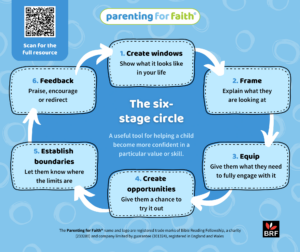The Six Stage Circle
A useful tool for helping a child become more confident in a particular value or skill.
This image is a reminder of the six stage circle, which is a tool for helping a child become confident in a particular value or skill. It’s easiest to get to grips with it using an example so we’re going to think about how we would use this tool to help your child become confident using chat and catch.

The six stage circle
Example with Chat and Catch
Model: Show what it looks like in your life
You model chat and catch by doing it yourself. Let your children see little bits of your prayer life. Pray aloud around your children. If you often pray in your head or away from them, as many of us are used to, then they can’t see and hear it. Share what God is saying to you and how you receive from Him. If this is new to you, that’s fine, let them see you having a go – you’re not trying to show a perfect textbook example just your real life version of what this looks like for you at the moment.
Frame: Explain what they are looking at
Explain to your kids how God communicates with you. They may not know what you mean if you say ‘I sense God told me this’. You need to explain exactly how you caught from God, for example ‘I was reading my Bible and a picture popped into my head’. Explain that you can talk to God about anything, anytime, anywhere and also how and why you are doing it. This doesn’t need to be a big teaching session, just little comments as you go through the day, things like ‘I’m worried about this meeting, I’m just going to tell God how I’m feeling about it and ask Him to help me’, and afterwards, ‘I love knowing that He wants to hear whatever I want to chat about’.
Equip: Give them what they need to fully engage with it
Give them ideas and prompts of things to chat to God about or questions to ask Him. There are some ideas, particularly for younger children, here. Tell them the different ways that God can communicate with us, so that they know what to expect. With an older child, you might want to watch some of session 5 with them (from 9:40 to 22:30) and chat about it afterwards or perhaps ask them how they think God speaks to us and help them fill in any bits they’ve missed.
Create opportunities: Give them a chance to try it out
As you go about your normal activities of the day, remind them that God is listening and ready to hear anything they want to share with Him, and that He has things to share with them too. You also might want to set aside a slightly longer time to focus on chatting and catching. Some people do this as part of the bedtime routine.
Create opportunities for your child to be powerful within your family, like asking your child to catch from God for you or about a family decision. If they don’t know what to do and come to you for advice, maybe you could encourage them to take ten minutes to go away and catch first before jumping in with your ideas.
Establish boundaries: Let them know where the limits are
Decide what the boundaries are going to be with your child. You might want to decide that for a few minutes before they go to sleep, you always encourage them to connect with God, but they can choose to do this in any way that they want to. Perhaps for catching, you might say that you’d love them to try catching from God first before coming to you for advice and that you’re happy to help them if they’re finding it tricky. The boundary might just be that you all have a go at chatting and catching every day.
Feedback: Praise, encourage or redirect
From your outside perspective, share what you see in their life and the fruit of their communication with God, this might be something like ‘I see that when you caught from God you looked different’ or ‘I can see you love telling God jokes, we’ll have to try and think of some new ones’. They might need some help learning to discern what is from God, there are some ideas for how to do that here. You can share your perspective or ask questions to help them figure it out, like ‘Does that match up with what we know about God’s character from the Bible?’ or ‘What else could that mean?’.
You can find more on chat and catch in sessions 4 and 5 of the Parenting for Faith course and more on the six-stage circle and examples of how to use it in sessions 6 (from 1:40 to 10:30) and 8 (from 7:08 to 25:45). There are also lots more worked examples in Parenting Children for a Life of Purpose.

